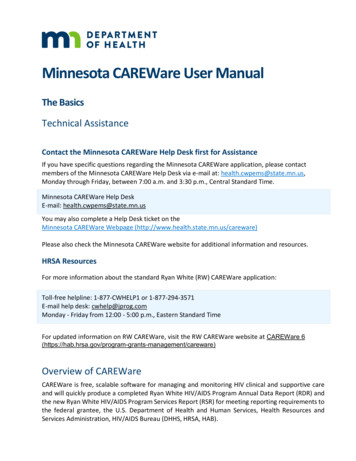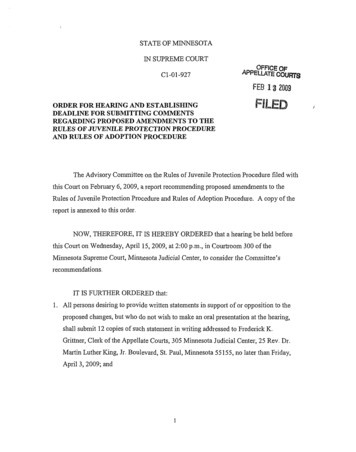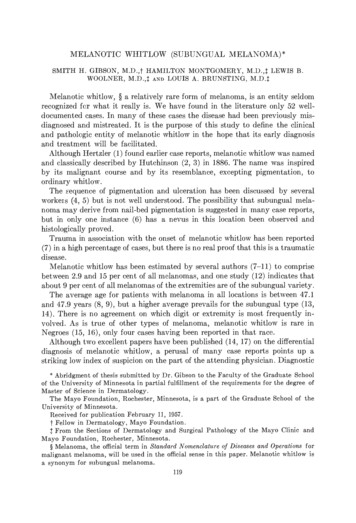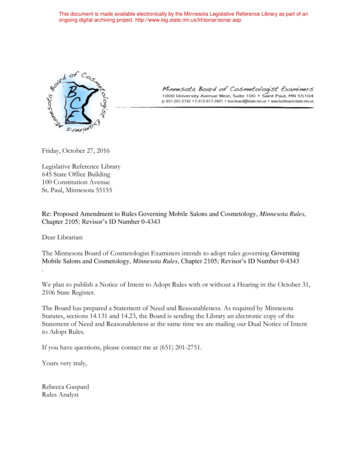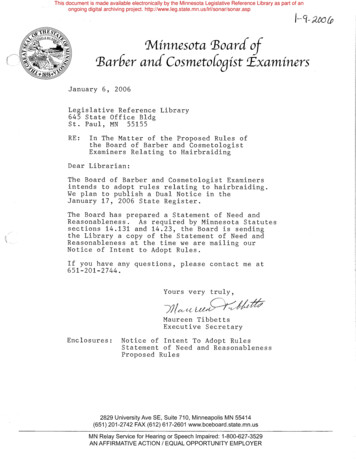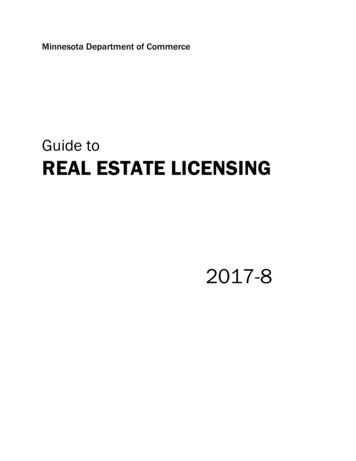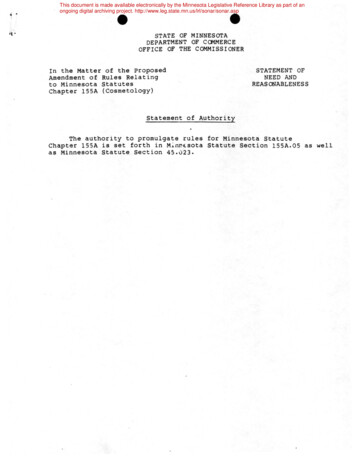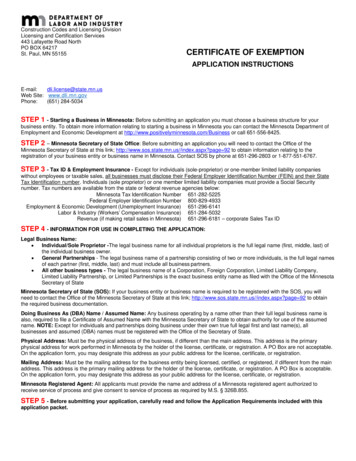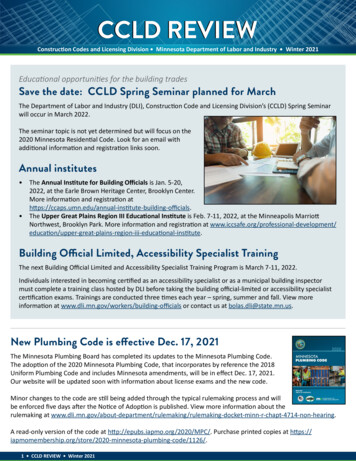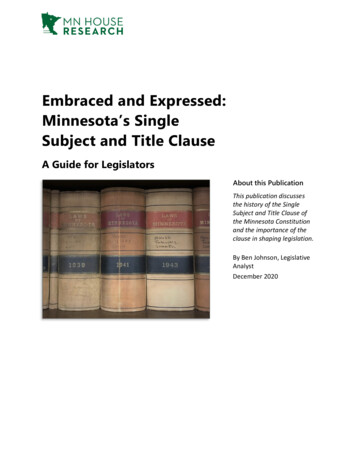
Transcription
Embraced and Expressed:Minnesota’s SingleSubject and Title ClauseA Guide for LegislatorsAbout this PublicationThis publication discussesthe history of the SingleSubject and Title Clause ofthe Minnesota Constitutionand the importance of theclause in shaping legislation.By Ben Johnson, LegislativeAnalystDecember 2020
ContentsExecutive Summary. 1Introduction . 1Origin of the Single Subject and Title Clause . 2Early Court Decisions: A Focus on Fraud . 3Developing a Test Amid Increasing Litigation . 4Establishing a Single Subject Test . 5Establishing a Title Test. 6Increasing Deference to the Legislature . 8Growing Concerns About Lengthy Bills. 9Major Opinions on the Single Subject and Title Clause . 11Associated Builders . 11Unity Church of St. Paul . 12Otto . 13Current State of the Law . 14One Clause, Two Requirements. 14Single Subject . 14Titles . 15Remedies. 15Questions for Legislators to Consider . 16Developing Legislation . 16Amending Legislation . 17Challenged Legislation . 18Conclusion . 18This publication was prepared by Ben Johnson, a legislative analyst specializing in the area ofcivil law. Questions can be addressed to Ben at ben.johnson@house.mn.Minnesota House Research Department provides nonpartisan legislative, legal, andinformation services to the Minnesota House of Representatives. This document canbe made available in alternative formats.www.house.mn/hrd 651-296-6753 155 State Office Building St. Paul, MN 55155
Embraced and Expressed: Minnesota’s Single Subject and Title ClauseExecutive SummaryThe Single Subject and Title Clause of the Minnesota Constitution says that no law canembrace more than one subject, and the subject must be expressed in the law’s title. Butwhat is a “subject,” and how much information must be stated in the title? As legislatorsconsider how to structure bills to address complicated issues, it is helpful to understand howcourts have interpreted this clause.This publication reviews the origins of the Single Subject and Title Clause, summarizes theearly court decisions that granted the legislature broad discretion in identifying subjects andassigning titles, explores how this clause developed into two separate tests, and discusses themodern revival of court challenges citing the clause in light of increasingly large andmultifaceted omnibus bills. The publication concludes by describing the remedies courts usewhen there is a violation of the clause and identifying questions legislators may wish toconsider as they prepare and review legislation.Introduction“No law shall embrace more than one subject, which shall be expressed in itstitle.” Minnesota Constitution, Article IV, Section 17The legislature often considers bills that span hundreds of pages, sometimes 900 pages ormore. Many legislators and members of the public wonder if bills of this length can truly beconsidered to embrace a single subject that is expressed in the bill’s title as required by theSingle Subject and Title Clause of the Minnesota Constitution.The legislature creates, amends, and votes on bills. Once enacted, those bills become acts andare state law. While a bill cannot be challenged unless and until it becomes an act of thelegislature, the Single Subject and Title Clause limits the way in which the legislature canstructure bills. Its authors hoped to promote transparency in the legislative process bypreventing the legislature from enacting legislation that included multiple unrelated, andpossibly controversial, provisions and from hiding the contents of a bill until it became law.In the late 1800s and early 1900s, parties regularly challenged laws based on alleged violationsof the clause, and the courts struck down several of the challenged laws. By the 1930s therewere fewer challenges that cited the clause, and by the 1970s courts made it clear that theywould give great deference to the legislature. 1As the legislature increasingly moved toward passing legislation in large omnibus bills,individual legislators, members of the public, and the Minnesota Supreme Court questioned1See, Lifteau v. Metropolitan Sports Facilities Commission, 270 N.W.2d 749 (1978) (emphasizing the need to deferto the legislature given the growing complexity of the legislative process in modern times).Minnesota House Research DepartmentPage 1
Embraced and Expressed: Minnesota’s Single Subject and Title Clausewhether those acts violate the Single Subject and Title Clause.2 In 2000, the supreme courtfound a section of a large omnibus act unconstitutional. 3 A few years later, the court of appealsfound the Personal Protection Act unconstitutional for similar reasons. 4But, as can be seen from more recent bills that passed the legislature, large omnibus billscontinue to be common. This publication is designed to help legislators determine whenlegislation is within, or outside, the limits of the Single Subject and Title Clause. The followingsections discuss the purpose of the clause, its historical development, the current standardsemployed by the courts, and questions for legislators to consider as they review legislation.Origin of the Single Subject and Title ClauseAs part of the Minnesota Constitutional Convention in 1857, delegates decided to include theSingle Subject and Title Clause. 5 The original draft included a title requirement that said: “No Billshall be passed by either House, embracing any subject not referred to in its title.” 6 Inproposing the addition of a single-subject provision, Bradley Meeker, a delegate to theConstitutional Convention, said, “My object in moving this amendment, is to guard against apractice which has been to a greater or less extent, prevalent in this Territory, as well as inother States, of grouping together several different subjects in one bill, and passing themthrough by means of a system known as log rolling.” 7 The proposal received no debate and theadopted provision read: “No law shall embrace more than one subject, which shall beembraced in its title.”8 The language of the clause has not changed and it became Article IV,section 17, of the Minnesota Constitution.2The court began to publicize its concern in the mid-1980s. See, State ex rel. Mattson v. Kiedrowski, 391 N.W.2d777 (Minn. 1986) (Yetka concurrence); Blanch v. Suburban Hennepin Regional Park Dist., 449 N.W.2d 150 (Minn.1989).3Associated Builders and Contractors v. Ventura, 610 N.W.2d 293 (Minn. 2000).4Unity Church of St. Paul v. State, 694 N.W.2d 585 (Minn. App. 2005).5The Debates and Proceedings of the Minnesota Constitutional Convention, 262–263, Francis H. Smith, reporter;St. Paul: E. S. Goodrich, territorial printer, 1857.6Id., at 262.7Id. at 262-263.8Id.; The Minnesota Supreme Court discussed this history at length in Associated Builders & Contractors v.Ventura, 610 N.W.2d 293 (Minn. 2000), a significant decision that found a violation of the Single Subject and TitleClause for the first time in several decades. A detailed discussion of the case appears below.Minnesota House Research DepartmentPage 2
Embraced and Expressed: Minnesota’s Single Subject and Title ClauseEarly Court Decisions: A Focus on FraudThe Constitutional Convention met in 1857 and the Minnesota Supreme Court decided its firstcase involving the Single Subject and Title Clause in 1858. The law at issue in that case bothreorganized political divisions in the states from a system of counties to a system of countiesand townships, and also required the register of deeds to deliver tax documents to the countyboard of supervisors.9 The court determined that the act did embrace more than one subject,but concluded that the act did not violate the constitution because there was “no attempt atfraud, or the interpolation of matter foreign to the subject expressed in the title, but an honesteffort to create a system of town, and through the town, county government, similar to that ofother states.” 10This first opinion established that the primary consideration of the court would be whetherthere was any fraud involved in challenged legislation.Four years later, the court again indicated that it would focus on the question of fraud. TheHennepin County Sheriff had seized a team of mules from the plaintiff in the case in order tosettle a lien, and the plaintiff sought to recover the mules because they could not be seizedunder “An Act for Homestead Exemption.” The sheriff argued that the act was unconstitutional,but the court stated that there was “no pretense of fraud” in the passage of the law. 11The first time the court struck down a law, it did so with minimal discussion. The author of thecourt’s opinion cited the 1858 and 1862 decisions and expressed the opinion that the act metthe standard set forth in those cases, but stated that a majority of the court felt that the“objection must be sustained.” 12The court returned to its focus on fraud in an 1868 case. 13 A criminal defendant had been foundguilty of murder and objected to the trial moving to different counties. 14 The law in questionconsisted of eight sections, and the defendant argued that the eighth addressed a differentsubject than the first seven. The court disagreed, noting that the final section was “germane” tothe other sections and emphasizing that the “constitutional restriction must be liberallyconstrued” because “strict adherence to its letter would seriously interfere with the practicalbusiness of legislation, and would frequently nullify laws not repugnant to its spirit or9Bd. of Sup'rs of Ramsey Cty. v. Heenan, 2 Minn. 330, 339 (1858).10Id.11Tuttle v. Strout, 7 Minn. 465 (1862).The plaintiff in the case argued that the law dealt with three subjects in relation to railroads: consolidation,bridging the Mississippi River, and taxation. Winona & St. P. R. Co. v. Waldron, 11 Minn. 515, 529 (1866).12Another case, State v. Kinsella (14 Minn. 524, 526 (Minn. 1869)) warned that interpretation of the clause couldnot be too broad “without letting in the evils which the provision was intended to exclude.”1314State v. Gut, 13 Minn. 341 (1868), aff'd sub nom. Gut v. State of Minnesota, 76 U.S. 35, 19 L. Ed. 573 (1869).Minnesota House Research DepartmentPage 3
Embraced and Expressed: Minnesota’s Single Subject and Title Clausemeaning.” 15 While the court felt that the title was not clear or accurate, it concluded that it wassufficiently suggestive and that there was no pretense of fraud. 16Developing a Test Amid Increasing LitigationIn the 1870s and early 1880s, the court saw and rejected a few challenges citing the SingleSubject and Title Clause.17 Most of the rejections came with little commentary. But, a significantspike in litigation over the next few decades resulted in development of a test for assessingchallenges to legislation.While there have been challenges citing the clause in every decade since the 1850s, 44appellate decisions addressed the clause in the last decade of the 1800s and there wereanother 19 opinions in the first decade of the 1900s—more than the 56 decisions in the 80years between 1940 and 2019.18Appellate Opinions Addressing theSingle Subject and Title Clause504540353025201510501850s 1860s 1870s 1880s 1890s 1900s 1910s 1920s 1930s 1940s 1950s 1960s 1970s 1980s 1990s 2000s 2010s15Id. at 349-350.16Id. at 350.Barton v. Drake, 21 Minn. 299 (1875); State v. Cassidy, 22 Minn. 312 (1875); State v. McFadden, 23 Minn. 40(1876); State v. City of Lake City, 25 Minn. 404 (1879); Hoffman v. Parsons, 6 N.W.797 (Minn. 1880).17The chart includes all decisions by the Minnesota Supreme Court, Minnesota Court of Appeals, Minnesota TaxCourt, and Eighth Circuit Court of Appeals. As a result, a few cases produced opinions issued by more than onecourt: Metropolitan Sports Facilities Com’n v. County of Hennepin (tax court and supreme court both in 1991);Associated Builders and Contractors (decided by the court of appeals as Associated Builders and Contractors v.Carlson in 1999 and by the supreme court as Associated Builders and Contractors v. Ventura in 2000); and Otto v.Wright County (court of appeals in 2017 and supreme court in 2018).18Minnesota House Research DepartmentPage 4
Embraced and Expressed: Minnesota’s Single Subject and Title ClauseIn 1875, the court reviewed its earlier decisions and attempted to explain what the clauserequired: if the legislature is fairly apprised of the general character of an enactment bythe subject as expressed in its title, and all its provisions have a just and properreference thereto, and are such as, by the nature of the subject so indicated, aremanifestly appropriate in that connection, and as might reasonably be looked forin a measure of such character, then the requirement of the constitution iscomplied with.19Perhaps recognizing that this description of the clause provided little guidance, the court laterexpressed its opinion that it was nearly impossible to establish a general rule for assessingwhether a particular act met the constitutional requirements. 20 That opinion suggested ageneral standard for assessing challenges. It emphasized that the clause should be given abroad, general construction and noted that it does not matter if an act technically embracesmore than one subject, or if the title does not include every subject addressed in the act, aslong as the subjects “are not at variance” with the subject expressed in the title. 21Establishing a Single Subject TestA year after identifying the difficulty of establishing an appropriate test, the court issued itsopinion in Johnson v. Harrison, which is widely cited as the best description of the test a courtshould apply when assessing whether an act has violated the single subject requirement. 22 Thecourt emphasized that the clause had two purposes: (1) preventing logrolling legislation oromnibus bills in which a number of different and disconnected subjects are united in one bill;and (2) preventing surprise and fraud by including subjects not identified in the title. 23 Inassessing challenges to legislation, the court indicated that the primary test should be whetherthe act “is within the mischiefs intended to be remedied.” 24The opinion focused on the question of whether legislation addressed more than one subjectand emphasized that it should be given a broad and general construction: “It is not intended,nor should it be so construed as, to embarrass legislation by making laws unnecessarilyrestrictive in their scope and operation, or by multiplying their number, or by preventing the19State v. Cassidy, 22 Minn. 312, 324 (1875).20State ex rel. Nash v. Madson, 45 N.W. 856, 856 (1890).21Id., at 856-857.See, e.g. State v. Erickson, 125 Minn. 238 (1914); State v. Helmer, 211 N.W. 3 (Minn. 1926); Sverkerson v. City ofMinneapolis, 283 N.W. 555 (Minn. 1939); State v. Meyer, 37 N.W.2d 3 (Minn. 1949); Visina v. Freeman, 89N.W.2d 635 (Minn. 1958); State v. Bell, 157 N.W.2d 760 (Minn. 1968); Wass v. Anderson, 252 N.W.2d 131 (Minn.1977); State ex rel. Mattson v. Kiedrowski, 391 N.W.2d 777 (Minn. 1986); Associated Builders and Contractors v.Ventura, 610 N.W.2d 293 (Minn. 2000); Unity Church of St. Paul v. State, 694 N.W. 2d 585 (Minn. App. 2005); andOtto v. Wright County, 910 N.W.2d 446 (Minn. 2018).2223Johnson v. Harrison, 50 N.W. 923, 924 (Minn. 1891).24Id.Minnesota House Research DepartmentPage 5
Embraced and Expressed: Minnesota’s Single Subject and Title Clauselegislature from embracing in one act all matters properly connected with one generalsubject.” 25As a result, the term “subject” must be given a broad interpretation and “may be ascomprehensive as the legislature chooses to make it.” 26 An act would only violate the SingleSubject and Title Clause if it embraced “two or more dissimilar and discordant subjects that byno fair intendment can be considered as having any legitimate connection with or relation toeach other.” 27 All that is required, the court added, is that all matters should fall under “someone general idea, be so connected with or related to each other, either logically or in popularunderstanding, as to be parts of, or germane to, one general subject.” 28 Later opinions refer tothis as the test of germaneness.In short, the subject of an act can be as broad as the legislature chooses; every provision in anact must be germane to that one subject, meaning the subjects must have some legitimateconnection to the one subject; and courts should give the requirement a broad, generalconstruction.Establishing a Title TestWhile multiple decisions addressed the titles of various acts, the court did not announce aunified test until 1902. Before that, opinions were somewhat inconsistent. 29 The court reviewedthose cases and pulled out the unifying themes, concluding:Every reasonable presumption should be in favor of the title, which should bemore liberally construed than statutes giving to the general words in such titleparamount weight. It is not essential that the best or even an accurate title beemployed, if it be suggestive in any sense of the legislative purpose. The remedyto be secured and mischief avoided is the best test of a sufficient title which is toprevent it from being made a cloak or artifice to distract attention from the25Id.26Id.27Id.28Id.In State v. Gut, 13 Minn. 341, 350 (1868), the court found a title valid even where “the subject of this law is notclearly or accurately expressed in its title.” But a year later, the court struck down a law whose title said that itwas “incorporating the village of High Forest” because it also divided and organized the town. State v. Kinsella, 14Minn. 524 (1869). In 1885, the court first struck down a provision in “An act relating to the Mississippi BoomCorporation” because the section required other businesses to give the Mississippi Boom Corporation noticewhen their logs were to go over the Falls of St. Anthony, and then upheld “An act to regulate the foreclosure ofreal estate” even though the title only suggested mortgage foreclosure actions and the law included executions.In an 1886 decision, State ex rel. Rice v. Smith, 28 N.W. 241, 243 (Minn. 1886), the court struck down a law wherethe title referenced the amendments it made to an 1878 law but also repealed an 1877 law that “related to thesame general subject of tax proceedings.” Just a few years later, the court said: “it was never claimed that everyother act which it repeals or alters by implication must be mentioned in the title of the new act.” City of Winonav. School Dist. No. 82, 41 N.W. 539, 540 (Minn. 1889). While the opinions may not have been directlycontradictory, they did not provide clear direction as to what a title needed to contain to satisfy the constitution.29Minnesota House Research DepartmentPage 6
Embraced and Expressed: Minnesota’s Single Subject and Title Clausesubstance of the act itself. The title, if objected to, should be aided if possible byresort to the body of the act, to show that it was not intended by such title tomislead the legislature or the people, nor distract their attention from itsdistinctive measures.30Subsequent decisions clarified that titles could be general or restrictive. Where they weregeneral, they received a broad, general construction, but an act with a restrictive title, such as“An act to amend the sixth subdivision of section 4284 of the General Statutes of Minnesota for1894 as amended by chapter 95 of the Laws of 1901 relating to express trusts,” must be given anarrow construction and provisions outside that title are void.31 In that case, the sectionidentified in the title related only to municipal trusts but the act changed the requirements forother trusts. The court noted that the law would have been valid under a general title such as“An act relating to express trusts.”32In short, titles can be restrictive or general. If a title is restrictive, it must only address thesubjects or prior legislation directly referenced in the title. 33 In the more common cases, titlesare general and are likely to be valid unless they are so misleading that they distract attentionfrom the actual contents of the legislation. 3430State ex rel. Olsen v. Bd. of Control of State Institutions, 88 N.W. 533, 537 (Minn. 1902).31Watkins v. Bigelow, 100 N.W. 1104, 1108-09 (Minn. 1904).32Id., at 1109.See, Megins v. City of Duluth, 106 N.W. 89, 90 (Minn. 1906) (“It is true that general titles to statutes must beconstrued liberally and in a common-sense way, and it is sufficient if a general title is not a cloak for legislatingupon dissimilar matters. But when the title is restrictive, carving out for consideration a part only of a generalsubject, legislation under it must be confined within the same limits, and all provisions of the act outside of suchlimits are unconstitutional, even though such provisions might have been included in the act under a broadertitle.”); State v. Palmquist, 217 N.W. 108 (Minn. 1927) (A title that indicated it was amending a prior act to“enlarge the definition of indecent assault to include male persons” could not also change the age of consentfrom 14 to 16).33See, State v. Droppo, 147 N.W. 829, 830 (Minn. 1914) (“The title is crude and clumsy; but it is not misleading, noris it a cloak for inappropriate legislation.”)34Minnesota House Research DepartmentPage 7
Embraced and Expressed: Minnesota’s Single Subject and Title ClauseIncreasing Deference to the LegislatureThe court found that 17 acts violated the Single Subject and Title Clause from 1885 to 1907, justfive in the next 40 years, and there were no successful challenges at the appellate levelbetween 1947 and 1999.35Acts Found Unconstitutional Under theSingle Subject and Title Clause1210864201850s 1860s 1870s 1880s 1890s 1900s 1910s 1920s 1930s 1940s 1950s 1960s 1970s 1980s 1990s 2000s 2010sWhile earlier decisions noted that the clause should be given a broad and generalconstruction, 36 later opinions increasingly emphasized that fact. While only some opinions inthe 1920s and 1930s explicitly recited that the interpretation must be broad and general, 37references to that forgiving standard became more common in the 1940s. 38 By the 1950s, allbut one court that ruled on a challenge citing the clause mentioned this broad and generalThe single appellate decision in 1999 was issued by the court of appeals in Associated Builders, which thesupreme court upheld a year later. In the 1990s, a Minnesota district court found that a provision violated theclause in In re Grand Jury Subpoena for Legislative Telephone Records, 1993 WL 193288 (Dist.Ct.Minn. 1993).There is no appellate opinion in that case.35Courts use the term “liberal” to describe this broad interpretation. As used by the courts, the term does notrefer to a political ideology. Rather, it means that the interpretation should not be literal or strict.36State v. Helmer, 211, N.W. 3, 3 (Minn. 1926) (“This provision is always liberally construed to avoid undulyhampering legislative action; and doubts concerning the sufficiency of the title of an act are resolved in favor ofits sufficiency.”); Sverkerson v. City of Minneapolis, 283 N.W. 555, 558 (Minn. 1939) (“ when the parties are wellaware of the provision, the objection partakes somewhat of the technical and reason for liberal constructionexists.”)37C. Thomas Stores Sales Sys. v. Spaeth, 297 N.W. 9, 13 (Minn. 1941) (“The constitutional provision ought to bepractically and liberally construed.”); Blanton v. Northern Pac. Ry. Co., 10 N.W.2d 382, 386 (Minn. 1943) (theclause is to be given “broad and extended meaning”); State ex rel. Finnegan v. Burt, 29 N.W.2d 655, 657 (Minn.1947) (general title statutes should be liberally construed); State v. Meyer, 37 N.W.2d 3, 8 (the constitutionalprovision should be liberally construed).38Minnesota House Research DepartmentPage 8
Embraced and Expressed: Minnesota’s Single Subject and Title Clauseconstruction.39 The court continued to express its deference to the legislature through the1960s and 1970s.By the end of the 1970s and early 1980s, the court seemed to almost preclude futurechallenges citing the Single Subject and Title Clause.In a case the court decided in 1978, a bar owner brought a challenge to the act creating theMetropolitan Sports Facilities Commission and permitting that entity to impose taxes. 40 The titlebegan, “An act relating to metropolitan government; providing for sports facilities; establishinga sports commission and prescribing its powers and duties;” and the district court concludedthat “the title of the Act failed to give adequate notice of the provisions for the takeover of themetropolitan sports area.” 41 The supreme court disagreed, saying: “Were we to declare the Actinvalid by reason of its title, we would place in jeopardy many acts passed over the years by theMinnesota Legislature. One must understand the growing complexity of the legislative processin modern times.” 42Similarly, a decision issued in 1984 said that “it would have been better practice for thelegislature to break Chapter 553 into two separate acts, its provisions are marginally related,”but found that there was no constitutional violation.43 The court emphasized that strictadherence to the letter of the clause “would seriously interfere with the practical business oflegislation, and would frequently nullify laws not repugnant to its spirit or meaning.”44Two years later the court’s tone changed dramatically.Growing Concerns About Lengthy BillsTwo opinions in the second half of the 1980s signaled that the court intended to look moreclosely at challenges alleging that legislation violated the single subject provision of the SingleSubject and Title Clause.First, in 1986, the court found that an act was unconstitutional for other reasons and did notaddress the Single Subject and Title Clause. 45 The case involved an act in which the legislatureThomas v. Housing and Redevelopment Authority of Duluth, 48 N.W.2d 175, 190 (Minn. 1951); City of Duluth v.Northland Greyhound Lines, 52 N.W.2d 774, 777 (Minn. 1952); Western States Utilities Co. v. City of Waseca, 65N.W.2d 255, 265 (Minn. 1954); Visina v. Freeman, 89 N.W.2d 635, 653 (Minn. 1958). The exception is State v. Cityof Duluth, 56 N.W.2d 416 (Minn. 1952).3940Lifteau v. Metropolitan Sports Facilities Commission, 270 N.W.2d 749 (Minn. 1978).41Id., at 753.42Id.43Bernstein v. Commissioner of Public Safety, 351 N.W.2d 24, 25 (Minn. 1984).44Id.45State ex rel. Mattson v. Kiedrowski, 391 N.W.2d 777 (Minn. 1986).Minnesota House Research DepartmentPage 9
Embraced and Expressed: Minnesota’s Single Subject and Title Clausetransferred most of the responsibilities of the State Treasurer to the Commissioner of Finance. 46The bill enacted by the legislature was 273 pages long; had a title that covered two pages; andcontained 378 sections including “a section creating a council on Asian-Pacific Minnesotans, asection dealing with the revisor of statutes, one relating to agricultural land, one containingamendments to the Minnesota Zoological Garden, one establishing an Aspen recyclingprogram, and many others.” 47 Justice Yetka suggested the court had been too lax in applyingthe Single Subject and Title Clause and that, as a result, “garbage bills” 48 and “Christmas treebills” 49 were becoming too common.50 The concurrence concluded by saying that the court “willnot hesitate” to strike down legislation that violates the Single Subject and Title Clause“regardless of the consequences to the legislature, the public, or the courts generally.” 51The court of appeals took note of Justice Yetka’s warning, 52 but the practice of the legislaturedid not change dramatically. Three years later, the supreme court upheld another act, but builton the warnings delivered by Justice Yetka in Mattson. 53 The court concluded that the varioussections were germane to one general topic, but indicated that the connection was “a merefilament.” 54 It then warned that, if an act violated the Single Subject and Title Clause, the courtwas likely to find the entire act unconstitutional: “ since it is the presence of more than onesubject which renders a bill constitutionally infirm, it appears
Embraced and Expressed: Minnesota’s Single Subject and Title Clause Minnesota House Research Department Page 2 . whether those acts violate the Single Subject and Title Clause. 2. In 2000, the supreme court found a section of a large omnibus act unc

